- Investigations on aluminium hybrid composites reinforced with ZrB2/Al2O3/Multi-Walled Carbon Nanotube (MWCNT) for aerospace applications
Elaya Perumal Aa,*, Jinu GRa, Vidhyalakshmi Sb and Amal Bosco Jude Sc
aUniversity College of Engineering, Nagercoil, Kanyakumari, Tamilnadu, 629004, India
bNagercoil, Kanyakumari, Tamilnadu, 629004, India
cUniversity VOC College of Engineering, Thoothukudi, Tamilnadu,628008, India
The Aluminium Alloy (AA7050)
hybrid composites (AAHC’s) reinforced with 2-10 wt.% ZrB2
ceramic particles, 1-5 wt.% Al2O3 particles and
0.5-2.5 wt.% MWCNT in novel Vibro-compo casting through liquid casting
route. The ZrB2 and Al2O3 have been
introduced in the conventional method, and MWCNT is injected by argon gas.
Then, the stirring process was carried out in different temperatures to enhance
wettability between reinforcements and matrix. The developed AAHC’s were
characterised using a Scanning Electron Microscope (SEM) and Energy-dispersive
X-ray spectroscopy analysis (EDS). The mechanical properties like hardness,
tensile, impact and fatigue tests were performed on all the casted samples
elaborately. The dispersion of ZrB2 ceramic
particles and its implanting over the ductile Al7050 matrix was effectively
obtained, which shown superior mechanical properties when compared to
monolithic Al7050 alloy. The specimen contained 1.5%MWCNT + 6%ZrB2 + 3%Al2O3
reveals the greater tensile strength, which is 30.73% higher than the base
material. Besides, the EDS results ensured the manufacturing of Al 7050/MWCNT + ZrB2 + Al2O3
metal matrix composites successfully, and no other intermetallic phases were identified.
Keywords: ceramics, composite materials, metal matrix composites, mechanical properties, metals
Aluminium alloy hybrid composites are undergoing a
revolution in the aerospace industry. The AAHC has received much attention in
the past decade. Within the next few years, AAHC, likely to become a
significant composite material in aircraft. Currently, aluminium alloy 7050 is
used in the wing spar of aircraft structure [1], but it
has average strength level. In order to overcome this
disadvantage, researchers were focused on this aluminium alloy 7050 to
reinforce with TiC [2] and TiB2 [3]. Al3Zr
dispersoids were reinforced in aluminium alloy 7050
[4]. The Al2O3, ZrB2, SiC, TiC TiB2
are the most common ceramic materials chosen to reinforce aluminium alloys
[5-11]. This paper seeks to address the introduction of multi
reinforcements such as MWCNT, ZrB2, Al2O3
on aluminium alloy 7050. Several authors have attempted to define AAHC’s, but
as yet there are still no accepted results on AAHC’s. In the literature, there
are many composites by aluminium alloy 7050 much work on the potential of AAHC
has been carried out. The first studies on AAHC found that aluminium alloy 7050
was reinforced with TiC particles [2]. Experiments on aluminium alloy 7050
reinforced com- posite were performed
by a group of researchers [3]. Lin K [3] has developed and investigated the
machina- bility parameters of TiB2
particles reinforced with aluminium alloy 7050. They draw focus
on monophonic reinforcements such as TiB2. It was
suggested [12] that, the introduction of ZrB2 particles
on aluminium alloy 6061 has enhanced the properties of composites, and this
seems to be a positive approach. Research has tended to focus on the monophonic
introduction of reinforcement rather than the multi-entry of
reinforcements on aluminium alloy 7050. Baradeswaran
[13] contended that aluminium alloy 7075 metal matrix composite
enhances the mechanical properties, but they failed to provide adequate
information for multi-entry reinforce-
ments. The reinforcements phase have been tried with different weight
percentages to improve the mechanical and metallurgical properties of the
composite [14-19]. Literature survey reveals that aluminium alloy 7050 rarely
reinforced with MWCNT, TiC, TiB2, ZrB2 and Al2O3
in the liquid casting route. Similarly, few research
works are identified in hybrid composites using aluminium alloy 7050 as matrix
phase. This present work AA7050/MWCNT/ ZrB2/Al2O3
hybrid composites were developed through the Vibro compo casting
method to get superior interface bonding and increase wettability. Thus, the
key objective of this research work is to investigate the influence of the
MWCNT, ZrB2 and Al2O3 particles on
the mechanical properties such as tensile, microhardness, impact, fatigue and
characterised by SEM and EDS on hybrid composites.
Materials
In an attempt to do AAHC, Aluminium Alloy 7050-T7451
chosen as matrix phase and its chemical composition given in Table 1. The
Multiwall Carbon Nanotubes (MWCNT), ZrB2 and Al2O3
were chosen for the reinforcement phase and their specifications
mentioned in Table 2. The MWCNT supplied by AdNano
Technologies, Catalytic carbon vapour deposition (CCVD)
process were used to produce ultrapure multiwall Carbon Nanotubes. The
received Al2O3, ZrB2 particles have
been examined to confirm the size of the particles using Average particle size
analyser. The average particle size of Al2O3 is
50 µm and ZrB2 is 40 µm is confirmed, as shown
in Fig. 1(a) and 1(b). Similarly, the received MWCNT’s are analysed by scanning
electron microscopy equipment in the 100 nm × 60,000 and
100 nm × 30,000 scale. The SEM results confirm the presence of
MWCNT’s, as shown in Fig. 2(a) and 2(b). Transmission
Electron Microscopic analysis results are
shown in Fig. 2(c). The Raman spectroscopy examination
was conducted on MWCNT’s, and its results show good agreement with wavenumber
and Raman intensity in Fig. 2(d). The percentage of weight loss
examination of the MWCNT was performed against temperature; weight
loss percentage is nearly to zero at 700 oC in Fig.
2(e). XRD analysis was done on MWCNT, and the result exhibits the
chemical composition peaks of MWCNT’s are shown in Fig. 2(f).
Fabrication
method
The fabrication of composites carried out through liquid
metallurgy route via Vibro compo casting method. In this
work, a specific vibrator is attached with a crucible for superior dispersion
of MWCNT in the aluminium matrix. This method is in line with a substantially
the same as that used by Abbasipour [20] compo casting setup with some
modifications. The apparatus is consisting of alumina crucible with muffle
furnace, coated steel stirrer, reinforcement injection tube, crucible with a
vibrator is attached with the compo casting equipment, which is shown in Fig.
2(g). The melt temperature has measured by using the K-type thermocouple, and
Argon gas is used to inject the reinforcements to the vortex melt. The compo
casting equipment can easily be customised to suit all the conditions. It was
decided that the best equipment for this investigation because it is one of the
most suitable methods for casting Carbon Nanotubes. All samples
have prepared in the following two routes. Initially, ZrB2 and
Al2O3 introduced in the traditional
route, and MWCNT’s are injected and stirred in different temperatures
to enhance wettability between reinforcements and matrix. Crucible
was allowed to vibrate and preheated at 600 oC then
aluminium alloy 7050 is melted at 700 oC. The Preheated
ZrB2 and Al2O3 were mixed with
aluminium melt then stirred at speed 450RPM. MWCNT were injected by
argon gas to the semi-solid aluminium melt then stirred at 250RPM to enhance
good wettability of MWCNT’s. Finally, the molten metal has poured in
100 × 100 × 10 mm sized dye. Then, the samples were machined
as per various ASTM standards by ELECTRA wire
EDM machine (SPRINTCUT WIN-Pulse Generator: ELPULS 40A
DLX. Fig. 3(a)-3(f) show the machined samples for various mechanical and
tribological investigations.
Characterisation
The Tensile strength analysis has carried out on the
100 × 6 × 12 mm sized samples shown in Fig. 3(a) as
per ASTM standard E8M04 by Computerised Universal Testing
Machine TMC– CUTM – 50 kN model, Chennai. Then,
Microhardness examinations were Examined on the
20 × 10 × 6 mm sized samples shown in Fig. 3(c) as per
ASTM standard E18M by using Microhardness Testing Machine, Mitutoyo– HM113
Model, Japan. Izod impact tests have performed on
75 × 10 × 10 mm sized samples shown in Fig. 3(b) as
per ASTM standard D256 using Impact testing machine. Fatigue strength investigation
was conducted using computerised fatigue equipment supplied by AVJ
Engineering Services Coimbatore. Similarly,
material characterisations such as Scanning Electron Microscope – SEM, JEOL–
JSM 6390, Japan and Energy Dispersive Spectroscopy – EDS, Oxford Instruments–
INCA Energy 250 LN2 Closed, UK was used and conducted.
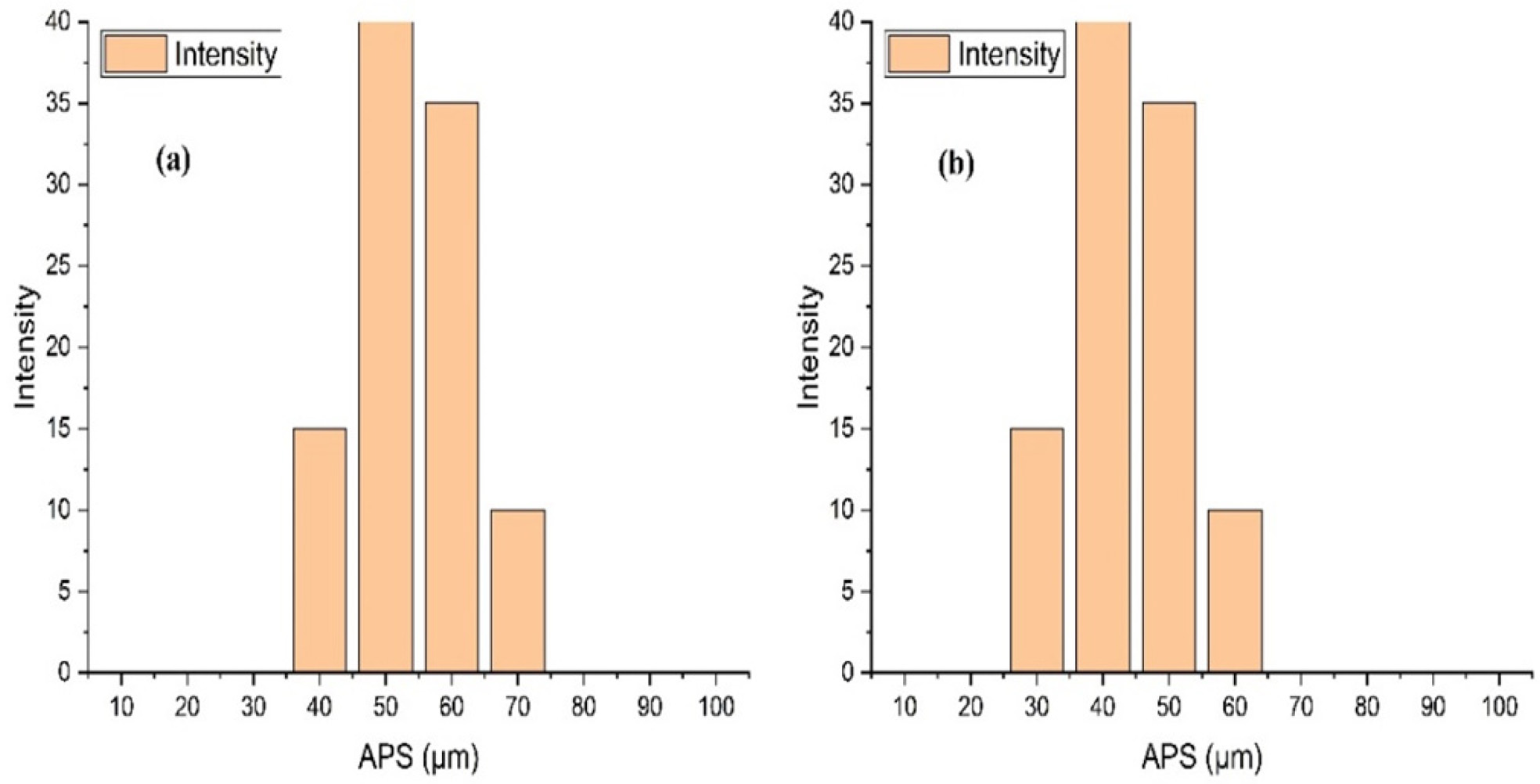
|
Fig. 1 (a) Average particle size analysis of Al2O3 reinforcement, (b) Average particle size analysis of ZrB2 reinforcement. |
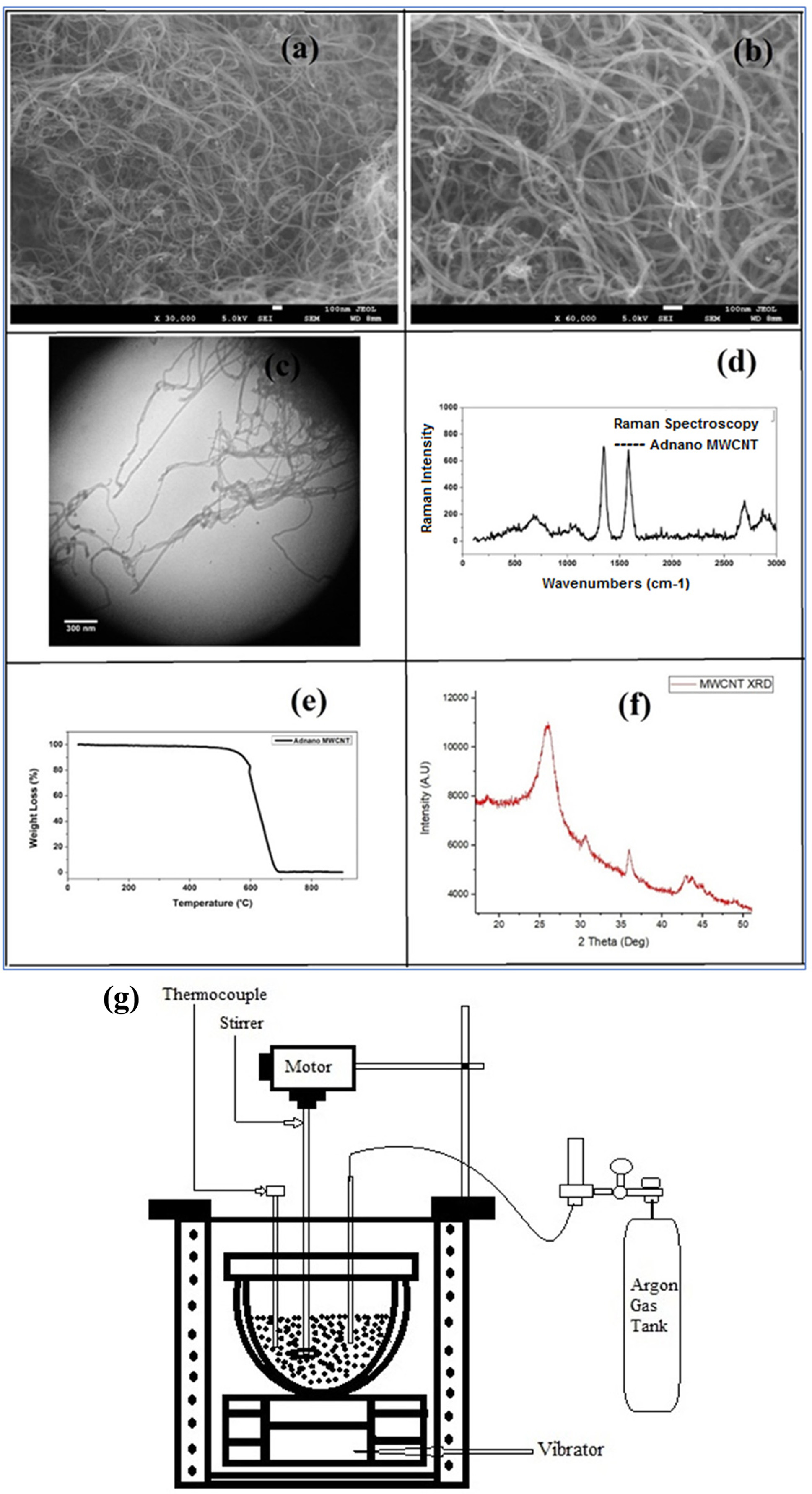
|
Fig. 2 (a), (b) and (c), Scanning Electron Microscopic and Transmission Electron Microscopic images of MWCNT’s, (d) Raman
spectroscopy analysis of MWCNT, (e) Weight loss analysis of MWCNT against temperature, (f) XRD analysis of MWCNT’s, (g) Schematic
Diagram of Stir casting setup. |
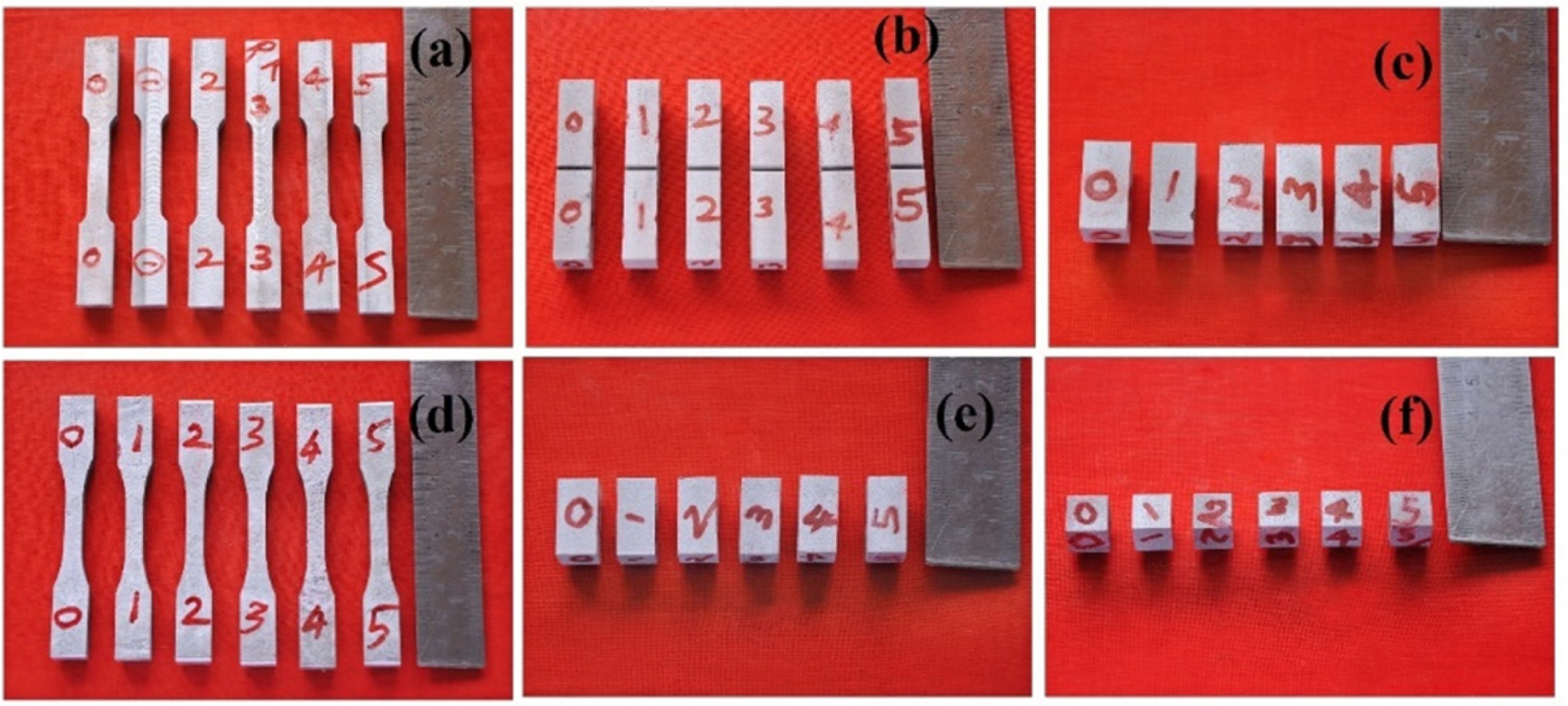
|
Fig. 3 Machined samples for Tensile, Impact, Micro Hardness, Fatigue, SEM and EDAX Investigations. |
Mechanical
properties of AA7050/MWCNT/ ZrB2/Al2O3
AAHC’S Tensile test
The internal resistive force against the load of the
composites was enhanced due to superior dispersion in matrix till the AA7050/
(1.5%MWCNT + 6% ZrB2 + 3%Al2O3)
composite, as shown in Fig. 4(a). From the Fig. 4(b), the ultimate tensile
strength of B, C and D composites are in increase trend while other two in downfall.
The ultimate tensile strength of E and F composites are decreasing due to the
increment of MWCNT, ZrB2 and Al2O3
particles and porosity due to the new cluster formation. The ZrB2
particles are surrounded by MWCNT’s. There is no Interfacial bonding due to the
lack of aluminium matrix phase in those composites. It is due to
the non-uniform dispersion between matrix and reinforcements.
Micro hardness test
The Vickers microhardness values of all casted samples are
examined. The Vickers Hardness Number is directly proportional to the
reinforcement’s weight percentage. An increasing trend was observed on AA7050/(0.5%MWCNT + 2%
ZrB2 + 1%Al2O3), AA7050/ (1%MWCNT + 4%ZrB2 + 2%Al2O3),A7050/(1.5%MWCNT + 6%ZrB2+3%
Al2O3),AA7050/(2%MWCNT + 8% ZrB2
+ 4% Al2O3)andAA7050/(2.5%MWCNT + 10% ZrB2 +
5% Al2O3) composites as shown in Fig. 4(c),which reveals
the increase of ZrB2, Al2O3 and
MWCNT rein- forced with aluminium
matrix enhance the Vickers hardness value. Al2O3 ceramic
particle was obstacles for the dislocation movement [21-23].
The Al2O3 particles protect the
aluminium alloy 7050 from infiltration and cutting of
slides on the surface of the composites [24, 25].
Impact test
Impact test results reveal the increasing trend in impact
strength till the AA7050/(1.5%MWCNT + 6% ZrB2 + 3%Al2O3)
composite, as shown in Fig. 4(d). Then,
downfall trend is observed in AA7050/(2% MWCNT + 8%ZrB2 + 4%Al2O3),
and AA7050/(2.5% MWCNT + 10%ZrB2 + 5%Al2O3)
composites due to its fragile nature because of more percentage of
reinforce- ments in
the aluminium matrix. The AA7050/(0.5% MWCNT + 2%ZrB2 + 1%Al2O3),
AA7050/(1%MWCNT + 4%ZrB2 + 2%Al2O3)
and AA7050/(1.5%MWCNT/6% ZrB2/3%Al2O3)
composites ensure the proper wettability and superior dispersion of
reinforcements in the aluminium alloy 7050
matrix.
Fatigue test
The fatigue strength was examined on all casted composites
as results shown in Fig. 5(a) to 5(f). The hybrid composite
revealed the fatigue resistance concerning load and time mentioned in Table 3.
Fig. 5(a) shows the casted aluminium alloy AA7050 has an average
fatigue strength. The increasing fatigue strength
identified in Fig. 5(b) to 5(d). The AA7050 specimen has fatigue
strength up to 200N load at 106 cycles then
failures at 101 cycles when the load increased
to 220N. Similarly, the fatigue strength and failure limit for all casted
composites were mentioned in Table 3. The composite AA7050/(1.5%MWCNT + 6%ZrB2 + 3%Al2O3
has enhanced fatigue strength to withstand the cyclic
stresses. These cyclic stresses lead to fatigue cracking, which is below the
static yield strength of the hybrid composite. The Fig. 5(e) and 5(f) show the
fatigue strength was significantly reduced in E and F hybrid composites
due to the existence of higher reinforcement percentage,
which leads to brittle phenomenon [26-30].
Microstructure
of MWCNT/ ZrB2/ Al2O3 AAHC’S
The SEM images of casted MWCNT/ ZrB2/
Al2O3 AAHC’S is depicted in Fig.
6(a) - 6(f). Fig. 6(a) indicates the SEM
image of the casted Aluminium Alloy 7050. The SEM microstructure image of
hybrid composite AA7050/(0.5%MWCNT + 2% ZrB2 + 1%Al2O3)
is shown in Fig. 6(b), which reveals the porosity and shrinkages presence are
less, which ensures the quality of Vibro compo casting and the similar trend
was absorbed in the AA7050/(1%MWCNT + 4% ZrB2 + 2%Al2O3
hybrid composite shown in Fig. 6(c). The SEM
microstructure image of AA7050/(1.5%MWCNT + 6%ZrB2 + 3%Al2O3)
exposes the dendritic structure of matrix alloy has disappeared due to the
presence of the MWCNT, ZrB2, and Al2O3
reinforcements as shown in Fig. 6(d). The SEM microstructure
images of AA7050/(2%MWCNT + 8%ZrB2 + 4%Al2O3)
and AA7050/(2.5%MWCNT + 10%ZrB2 + 5%Al2O3)
are shown in Fig. 6(e) and Fig. 6(f). This reinforcement particles
influence the grain formation in the semi-solid state of composite material and
enhance the better solidification. More grain refinement has been achieved by
finer grains due to reinforcements. The
intragranular distributions have found on casted samples, which
enhances the mechanical and tribological properties. The
influencing parameters for the distribution of reinforcements are
convection current, buoyant motion and movement of particles [31]. The
solidification front’s velocity has a significant role in deciding intra or
intergranular distribution. It has formed when the velocity of the
solidification front is above the critical velocity, which is
between 10-3 to 10-5 m/s [32]. The temperature gradient
is the influencing factor for the critical velocity and particle size. The SEM
images are showing the clear interface between the aluminium matrix and the
following reinforcements MWCNT, ZrB2, and Al2O3.
Moreover, no reaction products and interfacial reactions
are identified between the reinforcements. Various researchers reported that
the reaction products would surround the particle and weaken the
interfacial strength when a reaction occurs [33-36].
EDAX
Results of MWCNT/ ZrB2/ Al2O3
AAHC’S
Fig. 7(a) shows the Energy Dispersive Spectrum of cast
Aluminium Alloy 7050 and with its elements. The high-intensity
peak elements are representing Aluminium, zinc,
copper and magnesium, and low-intensity peak elements for ferrous,
Silicon, Manganese, Titanium, Chromium and Zirconium are identified.
The Fig. 7(b) shows EDS analysis of hybrid composite
AA7050/(0.5%MWCNT + 2%ZrB2 + 1%Al2O3)
with Carbon, Zirconium diboride and alumina. Similarly, no other elements
present in the AA7050/ (1%MWCNT + 4% ZrB2 + 2%Al2O3)
hybrid composites as Fig. 7(c) and hybrid composite
AA7050/(1.5%MWCNT + 6%ZrB2 + 3%Al2O3)
as Fig. 7(d). The presence of elements of AA7050-MWCNT/ZrB2/Al2O3
is rich in the casted samples
AA7050/(2%MWCNT + 8%ZrB2 + 4%Al2O3)
and AA7050/(2.5%MWCNT + 10%ZrB2 + 5%Al2O3)
as shown in Fig. 7(e) and 7(f). The EDS result reveals that no elemental
presence due to its interfacial reaction between the matrix and
reinforcements.
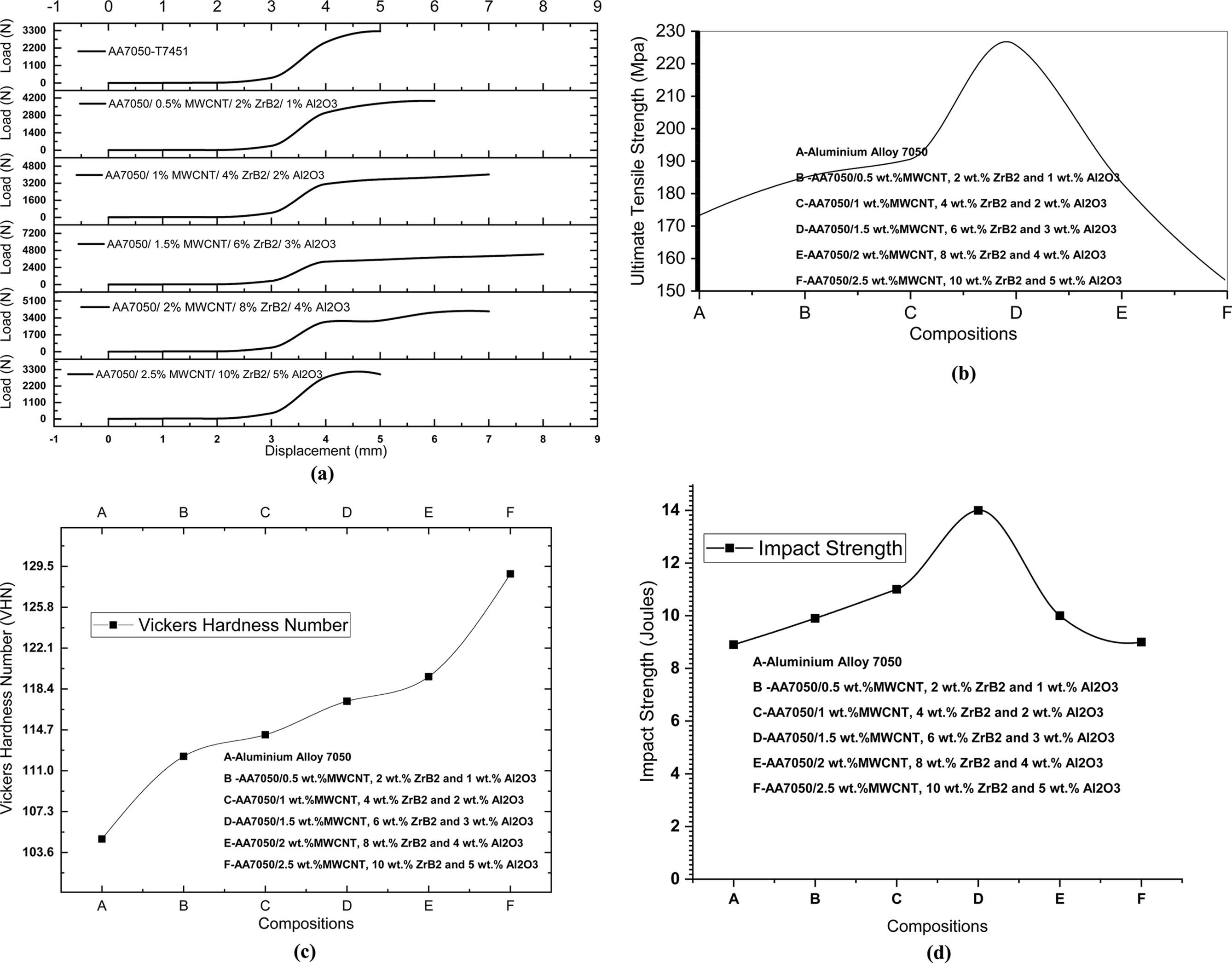
|
Fig. 4 (a) Load versus displacement curve for the tensile test of Hybrid composites, (b) Ultimate tensile strength of Hybrid composites, (c)
Vickers Hardness Number of Hybrid composites, (d) Impact Strength of Hybrid composites. |

|
Fig. 5 Results of fatigue cycles for time and Load; (a) AA7050, (b) AA7050/(0.5%MWCNT + 2%ZrB2 + 1%Al2O3), (c) AA7050/
(1%MWCNT + 4%ZrB2 + 2%Al2O3), (d) AA7050/(1.5%MWCNT + 6%ZrB2 + 3%Al2O3), (e) AA7050/(2%MWCNT + 8%ZrB2 + 4%Al2O3),
(f) AA7050/(2.5%MWCNT + 10%ZrB2 + 5%Al2O3) |
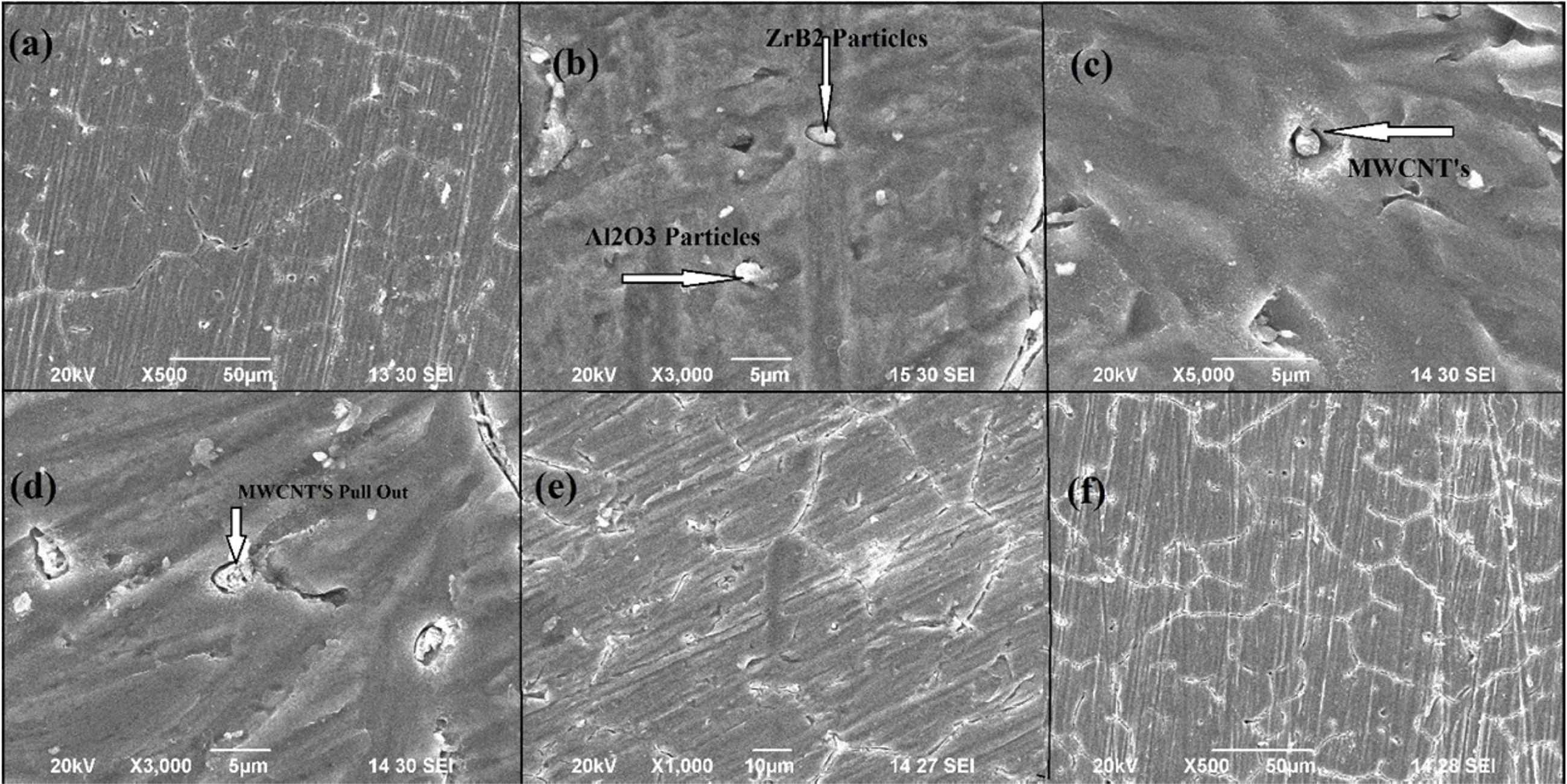
|
Fig. 6 (a) SEM microstructure images of AA7050, (b) SEM microstructure images of AA7050/(0.5%MWCNT + 2%ZrB2 + 1%Al2O3), (c)
SEM microstructure images of AA7050/(1%MWCNT+4%ZrB2 + 2%Al2O3), (d) SEM microstructure images of AA7050/
(1.5%MWCNT + 6%ZrB2 + 3%Al2O3), (e) SEM microstructure images of AA7050/(2%MWCNT + 8%ZrB2 + 4%Al2O3), (f) SEM
microstructure images of AA7050/(2.5%MWCNT + 10%ZrB2 + 5%Al2O3). |
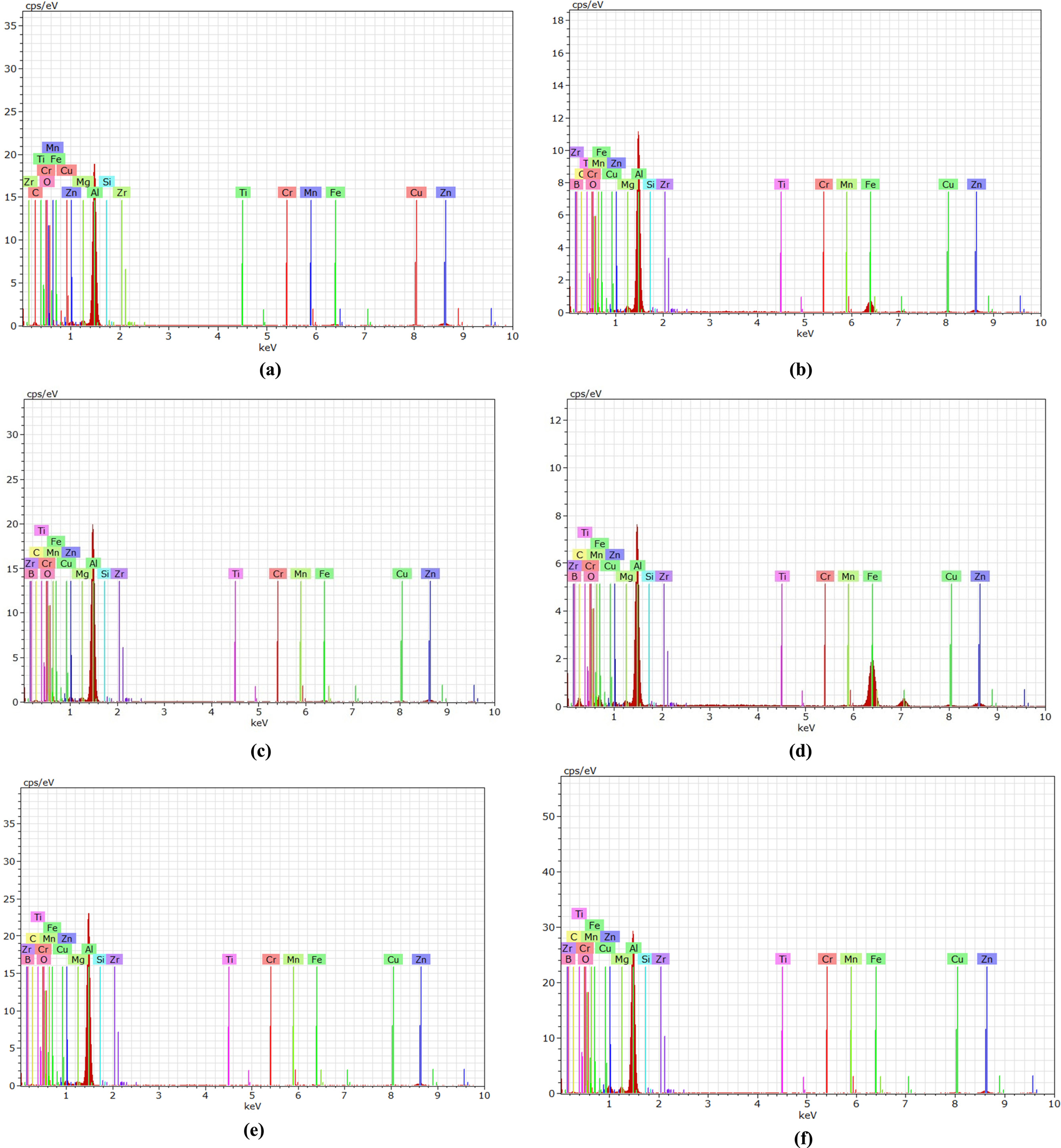
|
Fig. 7 (a) EDS test analysis of AA7050, (b) EDS test analysis of AA7050/(0.5%MWCNT + 2%ZrB2 + 1%Al2O3), (c) EDS test analysis of
AA7050/(1%MWCNT + 4%ZrB2 + 2%Al2O3), (d) EDS test analysis of AA7050/(1.5%MWCNT + 6%ZrB2 + 3%Al2O3), (e) EDS test
analysis of AA7050/(2%MWCNT + 8%ZrB2 + 4%Al2O3), (f) EDS test analysis of AA7050/(2.5%MWCNT + 10%ZrB2 + 5%Al2O3). |
|
Table 3 Fatigue Load obtained, cycles completed and result in the condition of Hybrid composites |
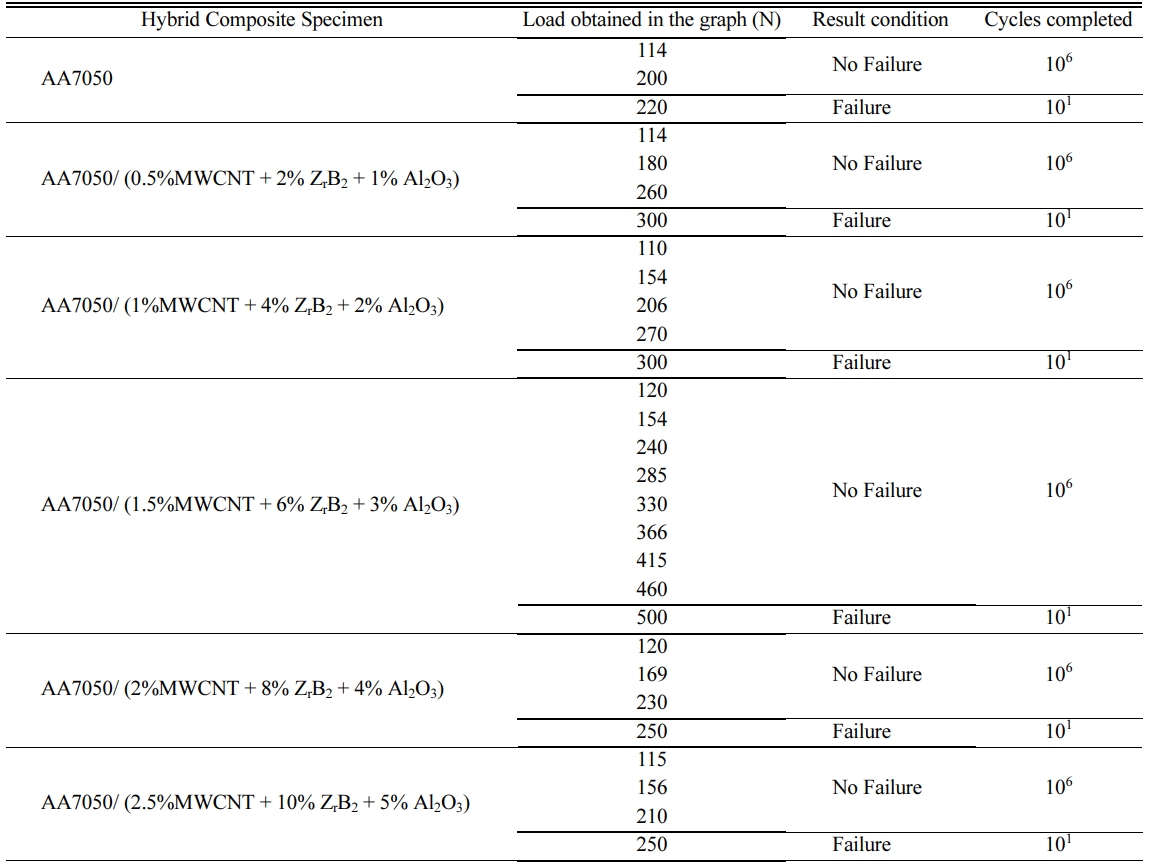
The Mechanical characteristics and microstructure study of
Vibro-compo cast AA7050 + MWCNT + ZrB2
+ Al2O3 aluminium hybrid composites were studied in
detail. The following achieved conclusions are drawn:
The superior interface bonding and wettability between the
reinforcement and AA 7050 matrix were achieved by novel Vibro compo casting
method. The ultimate tensile strength is enhanced by about 30.73% in Hybrid
composite compared with the base material. The impact strength and
microhardness of AA7050 hybrid composite reveal the increasing trend. The
tension-tension fatigue strength of hybrid composites confirms the
superior fatigue strength against the applied cyclic
loadings. The SEM images show the uniform dispersion between the matrix and
MWCNT, ZrB2 and Al2O3
reinforcements. EDS results reveal all elements of both matrix and
reinforcements are present in casted hybrid composite materials.
Corresponding author (A. ELAYA PERUMAL) gratefully
acknowledges the financial support from the Ministry of
Social Justice & Empowerment and Ministry of Tribal
Affairs, Government of India. This research work was supported by the Ministry
of Social Justice & Empowerment and Ministry of Tribal Affairs, Government
of India, under RGNF Scheme [Award Number:
F117.1/201617/RGNF201517SCTAM 25495]
There is no conflict of interest.
- 1. P. Rambabu, N.E. Prasad, V.V. Kutumbarao, and R.J.H. Wanhill, in “Aerospace Materials and Material Technologies” (Springer Singapore, 2017) p.29-52.
-

- 2. A. Ranganathan, P.V. Akshay Krishnan, A.S. Nambiar, S. Mohan Kumar, and V. Ravi Kumar, Mater. Today Proc. 5[11] (2018) 25368-25375.
-

- 3. K. Lin, W. Wang, R. Jiang, and Y. Xiong, Int. J. Adv. Manuf. Technol. 100[1-4] (2019) 143-151.
-

- 4. J.D. Robson and P.B. Prangnell, Acta Mater. 49[4] (2001) 599-613.
-

- 5. J.J. Zhuang, X.Y. Zhang, B. Sun, R.G. Song, and H. Li, Gongcheng Kexue Xuebao/Chinese J. Eng. 39[10] (2017) 1532-1539.
-

- 6. V. Mohanavel, S. Suresh Kumar, T. Sathish, and K.T. Anand, in: Mater. Today Proc. 5[5] (2018) 13601-13605.
-

- 7. M.T. Sijo and K.R. Jayadevan, Procedia Technol. 24 (2016) 379-385.
-

- 8. K. Ravi Kumar, K. Kiran, and V.S. Sreebalaji, J. Alloys Compd. 723 (2017) 795-801.
-

- 9. A. Chandana, I.D. Lawrence, and S. Jayabal, in: Mater. Today Proc. 5[6] (2018) 14317-14326.
-

- 10. S. Poria, P. Sahoo, and G. Sutradhar, Silicon 8[4] (2016) 591-599.
-

- 11. M. Narimani, B. Lotfi, and Z. Sadeghian, Surf. Coatings Technol. 285 (2016) 1-10.
-

- 12. S.R. Ruban, K.L.D. Wins, M.M. Boopathi, and A.A. Richard, Int. J. Mech. Eng. Technol. 9[2] (2018) 88-94.
- 13. A. Prakash, M. Dharmendira Kumar, A. Baradeswaran, R. Padma Priya, and A. Bagubali, J. Balk. Tribol. Assoc. 24[1] (2018) 1-14.
- 14. N. Panwar and A. Chauhan, in: Mater. Today Proc. 5[2] (2018) 5933-5939.
-

- 15. R. Sharma, S.J. P, K. Kakkar, K. Kamboj, and P. Sharma, Int. Res. J. Eng. Technol. 4[2] (2017) 832-842.
- 16. N. Gangil, A.N. Siddiquee, and S. Maheshwari, J. Alloys Compd. 715 (2017) 91-104.
-

- 17. S.T. Mavhungu, E.T. Akinlabi, M.A. Onitiri, and F.M. Varachia, Procedia Manuf. 7 (2017) 178-182.
-

- 18. C.T. Lynch and J.P. Kershaw, in “Metal Matrix Composites” (CRC, 2018) p.1-170.
- 19. Yashpal, Sumankant, C.S. Jawalkar, A.S. Verma, and N.M. Suri, in: Mater. Today Proc. 4[2] (2017) 2927-2936.
-

- 20. B. Abbasipour, B. Niroumand, and S.M. Monir Vaghefi, Trans. Nonferrous Met. Soc. 20[9] (2010) 1561-1566.
-

- 21. K. Shirvanimoghaddam, S.U. Hamim, M. Karbalaei Akbari, S.M. Fakhrhoseini, H. Khayyam, A.H. Pakseresht, E. Ghasali, M. Zabet, K.S. Munir, S. Jia, J.P. Davim, and M. Naebe, Compos. Part A Appl. Sci. Manuf. 92 (2017) 70-96.
-

- 22. Ş. Karabulut, U. Gökmen, H. Çinici, Compos. Part B Eng. 93 (2016) 43-55.
-

- 23. S. Sahraeinejad, H. Izadi, M. Haghshenas, A.P. Gerlich, Mater. Sci. Eng. A 626 (2015) 505-513.
-

- 24. V. Mohanavel, K. Rajan, P. V. Senthil, and S. Arul, in: Mater. Today Proc. 4[2] (2017), 3093-3101.
-

- 25. B.C. Kandpal, J. Kumar, and H. Singh, in: Mater. Today Proc. 4[2] (2017) 2783-2792.
-

- 26. R. Narayanan, C. Saravanan, V. Krishnan, and K. Subramanian, Mech. Mech. Eng. 19[1] (2015) 23-30.
- 27. D. Patidar and R.S. Rana, in: Mater. Today Proc. 4[2] (2017) 2981-2988.
-

- 28. M. Shukla, S.K. Dhakad, P. Agarwal, and M.K. Pradhan, in: Mater. Today Proc. 5[2] (2018) 5830-5836.
-

- 29. G. Moona, R.S. Walia, V. Rastogi, and R. Sharma, Indian J. Pure Appl. Phys. 56[1] (2018) 164-175.
- 30. V.C. Kale, IOSR J. Mech. Civ. Eng. 12[6] (2015) 31-36.
- 31. R. Bauri, D. Yadav, and G. Suhas, Mater. Sci. Eng. A 528[13-14] (2011) 4732-4739.
-

- 32. G. Wilde, M. Byrnes, J.H. Perepezko, J. Non. Cryst. Solids 250-252 (1999) 626-631.
-

- 33. P.S. Bains, S.S. Sidhu, and H.S. Payal, Mater. Manuf. Process. 31[5] (2016) 553-573.
-

- 34. A. V. Muley, S. Aravindan, and I.P. Singh, Manuf. Rev. 2[15] (2015) 1-13.
-

- 35. M.O. Bodunrin, K.K. Alaneme, and L.H. Chown, J. Mater. Res. Technol. 4[4] (2015) 434-445.
-

- 36. M. Kannaiyan, J.G. Raghuvaran, K. Govindan, and E.P. Annamalai, J. Ceram. Process. Res. 21[1] (2020) 26-34.
-

 This Article
This Article
-
2020; 21(5): 524-532
Published on Oct 31, 2020
- 10.36410/jcpr.2020.21.5.524
- Received on Mar 4, 2020
- Revised on Mar 27, 2020
- Accepted on Apr 2, 2020
 Services
Services
- Abstract
introduction
materials and methods
results and discussion
conclusion
- Acknowledgements
- Conflict of Interest
- References
- Full Text PDF
Shared
 Correspondence to
Correspondence to
- Elaya Perumal A
-
University College of Engineering, Nagercoil, Kanyakumari, Tamilnadu, 629004, India
Tel : +91-8903966003 - E-mail: skyforplay@gmail.com








 Copyright 2019 International Orgranization for Ceramic Processing. All rights reserved.
Copyright 2019 International Orgranization for Ceramic Processing. All rights reserved.